Flamethrowers were Barbaric But Effective
 |
| German Kleif Model 1916 of World War I. |
Flamethrowers were a characteristic feature of World War II, used extensively by both sides and all major powers. While flamethrowers have their origins in antiquity - Byzantine "Greek Fire" retained late-Roman control of the Mediterranean even as their fortunes on land declined, and the ancient Chinese also used them for centuries - flamethrower use in modern times stems from World War I. Hungarian Gábor Szakáts invented the modern flamethrower around the turn of the century, and the English word derives from the German "Flammenwerfer."
 |
| Here, U.S. Marine Corporal Charles Lindberg wields his flamethrower. Lindberg participated in the first flag-raising on Iwo Jima - the one that got no publicity - and was bitter that only the second, staged flag-raising became iconic (Credit: Dick Honyak). |
Richard Fiedler turned Szakáts' idea into reality in 1901, and entire German units were equipped with Flammenwerfern as early as 1911. The British invented their own flamethrowers and first used them in the Battle of Somme in 1916. The Germans used their Flammenwerfer units in virtually every major engagement of the war beginning with Verdun in 1915. Despite initial protestations by the Allies that the weapons were "inhumane" (an odd charge during such a war), by the end of World War I, all of the major powers, including France, Italy, and the Russians, used flamethrowers.
 |
| This Wehrmacht soldier, according to the caption on the back of the photo, used his flamethrower to capture 7 bunkers and 50 enemy soldiers in 1940 (colorized). |
The Treaty of Versailles banned flamethrowers, but Adolf Hitler had thrown that treaty aside by the mid-1930s. Reichsmarschall Hermann Göring, head of the Luftwaffe, placed the first order for flamethrowers, and 1,000 were produced by the beginning of 1939. That's a lot of flamethrowers, but Hitler had big plans.
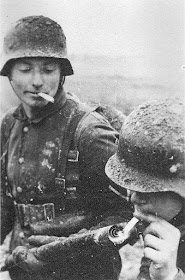 |
| Using a flamethrower for a rare non-destructive purpose. |
The Germans made use of flamethrowers right from the first day of World War II when they used them to ignite the Post Office in Danzig. The Flammenwerfer 35 was the flamethrower of choice during the first few years of the war. It later was supplemented by the Abwehrflammenwerfer 42, which were buried and used to defend German strong-points, and the Einstossflammenwerfer 46, which was smaller than the Flammenwerfer 35 and thus presented a smaller target to enemy counterfire. The Fm. W. 41 was a dual-canister flamethrower introduced in 1941, and 70,000 were produced. The standard German Flammenwerfer worked off of two tanks, one of which contained flammable oil and the other a pressurized inert gas to send the flame to a distance. The Flammenwerfer operated somewhat like an aerosol can.
 |
| Soldier of the Großdeutschland Infantry Division with a Flammenwerfer 40 on the Eastern Front, June 1941. |
The Italians and Japanese also used flamethrowers, though not as extensively as the Germans. The German Flammenwerfer 35 came in quite handy when the Wehrmacht invaded the Soviet Union, as flamethrowers made burning Russian and Ukrainian thatched huts quite easy - and this was a common occurrence during Operation Barbarossa in 1941, as the many photographs that were taken of such incidents attest.
 |
| A flamethrower in use in 1942, somewhere in the Soviet Union. |
German and Soviet Flamethrowers
It is common in war histories to see flamethrowers used only in the Pacific. This is far from what actually happened, and flamethrowers actually were used just as much - if not more so - in the European Theater of Operations as in the Pacific. According to Edwin Tunis, author of "Weapons: A Pictorial History":
The most dramatic hand weapon of World War II and the most effective for its purpose was the flamethrower.
The Germans used their Flammenwerfern to great effect in some of their early successes, such as their conquest of the fortress of Eben Emael. This particular operation illustrated perhaps the best and most enduring use of the flamethrower, its use against bunkers. With the enemy dug in, the flames from the Flammenwerfer could shoot down openings and consume the oxygen inside, replacing it with deadly smoke. If the flames actually burned the soldiers inside, so much the better - but they didn't have to. The barricaded soldiers, thinking they were secure, would be suffocated or blinded by the smoke and disoriented.
 |
| A Soviet soldier with a flamethrower in Stalingrad, 1942. |
The Soviets had flamethrowers during World War II, too. Theirs were slightly different than the Wehrmacht's Flammenwerfer, as they had three separate tanks.
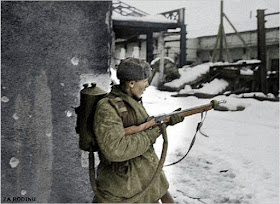 |
| A Soviet soldier showing off his flamethrower. |
Each separate tank of the Soviet model gave one shot, so an infantryman going into battle with a Soviet flamethrower could "light up" three times.
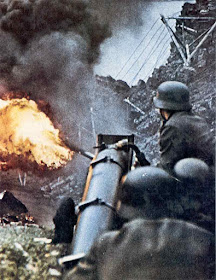 |
| German flamethrower at Stalingrad, 1942. |
Flamethrowers were both loved and hated by the troops. During cold weather, flamethrowers were a handy way to keep warm. However, it was common "grunt" wisdom to give the guys carrying flamethrowers a wide berth during invasions and other tricky operations, because one well-aimed (or lucky) bullet could cause their equipment to explode. You didn't want to be next to an exploding canister of flaming oil. Thus, the men carrying such weapons into battle had to be quite brave...
 |
| A flamethrower in use, likely during an exercise. |
While able to be carried by one soldier, Flammenwerfern required three-man teams. Two men would hold and direct the tube (up to 180 feet long), and a third would operate the tank’s controls and "shoot" the weapon.
 |
| Good view of a Flammenwerfer 35. |
The Germans realized after Stalingrad that, while handy, flamethrowers carried by individuals could not win battles by themselves. They modified some tracked vehicles to serve as mobile flamethrowers, but relatively few were built and used.
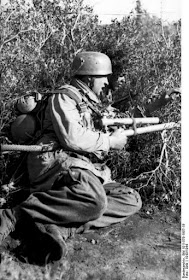 |
| A Fallschirmjager armed with a flamethrower in Italy, 1944 (Federal Archive). |
As Germany's fortunes declined, the Wehrmacht sought smaller weapons that inexperienced "soldiers" could use. Often wielded by overage Volkssturm recruits, the Einstoss-flammenwerfer 46 (People’s Flamethrower 46) was a compact, very lightweight (less than eight pounds) design. Some 15,000 cheaply and quickly producible “pipe-cartridge-trigger” devices were produced before the end of the war. These were similar to the Panzerfaust antitank weapons of the period. Flamethrower had the advantage of not requiring precise aim, and there was no time to train Volkssturm soldiers how to shoot, so these late-war flamethrowers met a military need.
 |
| German Fallschirmjager in Italy, 1944 (Elsner, Heinz, Federal Archive). |
The flamethrower declined in use as the German sphere of conquest shrank. Flamethrowers were relatively ineffective in urban environments and the open fields that characterized industrialized areas. While flamethrowers did not require vegetation - they supplied their own fuel - they were best suited to rural environments. For one thing, the flamethrower itself presented an irresistible and easy target for the enemy in urban and farm environments, where a sniper would have a clear line of fire across an open field or from a high floor of a building.
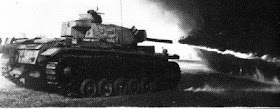 |
| A rare picture of a Panzer III (Fl) Flamm Sd.Kfz. 141/3 in action. They were manufactured by Wegmann from 1943-1945 and saw service. Reportedly, 100 were built, though by some accounts fewer actually reached the front lines. Hitler personally ordered the conversions. The Flammpanzer III carried 1 × 1.4 cm Flammenwerfer and 2 × 7.92 mm MG34 machine guns. They could cover 155 km at a top speed of 40 km/hr using their Maybach HL 120 TR 12 cylinder liquid-cooled Vee petrol engines producing up to 300 hp at 3,000 rpm (by comparison, the much heavier Tiger tank had a similar engine running at about 600 hp). |
Flamethrowers were better suited for forests and areas with flammable cottages and the like, which characterized much of the Soviet Union. The ground cover gave the man carrying the flamethrower some natural camouflage and protection, and fires could be started to spread throughout an entire area occupied by the enemy. While it looks dramatic, the last thing you wanted to be doing was charging across an open field with a flamethrower at an enemy able to fire back, your remaining lifespan could be measured in seconds in that situation.
 |
| A German Fallschirmjager (paratrooper) advancing over open ground with a flamethrower, 1944. This was quite hazardous. |
Allied Use of Flamethrowers in World War II
As noted above, the Allies at first professed to be squeamish about flamethrowers. However, they quickly overcame whatever scruples they may have had, and were using flamethrowers routinely by the end of World War I. While development lagged somewhat between the wars, flamethrowers were quickly embraced again by the Allies once they entered another shooting war.
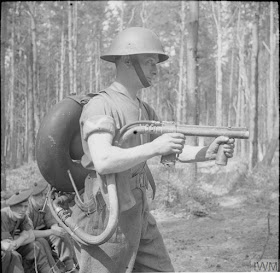 |
| "A soldier with 1st Battalion, King's Own Scottish Borderers, demonstrates the Lifebuoy man-portable flamethrower, Denmead, Hampshire, 29 April 1944." © IWM (H 37975). Notice his two mates to the rear. |
The British called their flamethrowers "Ack Packs." Somewhat similar to the Flammenwerfer, the Ack Packs had a doughnut-shaped fuel tank with a small spherical pressurizer gas tank in the middle. Due to their characteristic shape, the troops tended to call them "lifebuoys." Ack Packs officially were known as Flamethrower, Portable, No 2, though nobody called them that.
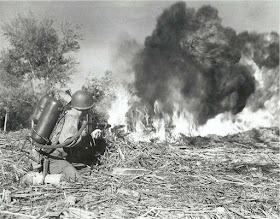 |
| A flamethrower in use on Peleliu during Operation Stalemate II, 1944. |
The U.S. military developed the backpack-type M2A1-7 flamethrower and M2-2 flamethrowers. The Americans used flamethrowers essentially in the same way that the Germans did, in areas with underbrush and forests.
 |
| A U.S. Marine with his M-2 flamethrower on Iwo Jima, February 1945 (colorized). |
By 1943, the United States was on the offensive in the Pacific. The Japanese had a strong military code that forbade retreat or surrender. Instead, they dug in after the U.S. soldiers invaded their islands, preparing elaborate bunkers and outfitting caves with artillery and other supplies. The Japanese would often not even defend the beaches too hard, knowing it was pointless, but instead would retreat in good order to their bunkers. This created ideal situations for U.S. use of flamethrowers to burn them out. It was a dirty business, but that is how World War II was.
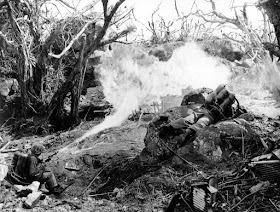 |
| A flamethrower in use on Iwo Jima, 4 March 1945. |
Like the Germans, the British and Americans eventually realized that flamethrowers carried by individuals did not provide sustained firepower. So, Major-General Percy Hobart decided to adapt some vehicles to serve as flamethrowers in order to assist the Normandy Invasion. Their primary tracked flamethrower was a variant of the Tank, Infantry, Mk VI (A22) Churchill Mark VII, called the Crocodile. These served with the 31st Armoured Brigade in northwest Europe and the 25th Armoured Assault Brigade in Italy. The Wehrmacht did not like the Crocodiles at all, and it is said that Crocodile crews were often executed upon capture.
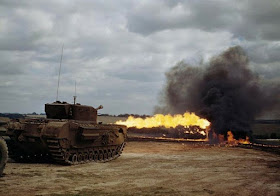 |
| A British Churchill Crocodile in action, most likely a demonstration on a proving ground. |
The Americans modified some Stuart and Sherman tanks to serve as flamethrowers. These proved unwieldy on islands covered by mountains and forests and took a lot of effort to get ashore, so they saw relatively little use.
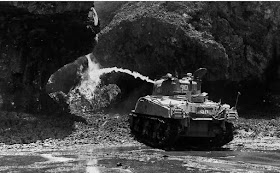 |
| M4 Sherman tank with a flamethrower mounted in place of a machine gun, New Caledonia, 10 October 1943. |
However, when a particularly troublesome Japanese bunker needed to be subdued, and one was around, a Stuart or Sherman with a flamethrower came in quite handy. As is well known, any job is easy if you have the right tool, and a mounted flamethrower was the right tool for certain troublesome enemy positions.
 |
| A flamethrower in use on Okinawa, 1945. |
The United States military continued to use flamethrowers long after World War II. For various reasons, including the fact that U.S. soldiers allegedly committed atrocities using flamethrowers (setting fire to native huts, as the Wehrmacht had done), the U.S. Army discontinued their use after the Vietnam War. However, personal flamethrowers are legal throughout almost all of the United States as of 2017, and they have experienced somewhat of a resurgence in recent years for personal defense. Aerosol-can sized flamethrowers are being marketed to women, who can carry small flamethrowers in their purses and use them to ward off attacks.
 |
| A U.S. Marine en route to Iwo Jima with his "Miss Spitfire" flamethrower. |
2020























thank you so much for uploading this information. i first saw the flamethrower used in episodes of Victory at Sea as a boy. i've often wondered about the nightmares operators of this killing machine experienced after the war when they returned home.
ReplyDelete